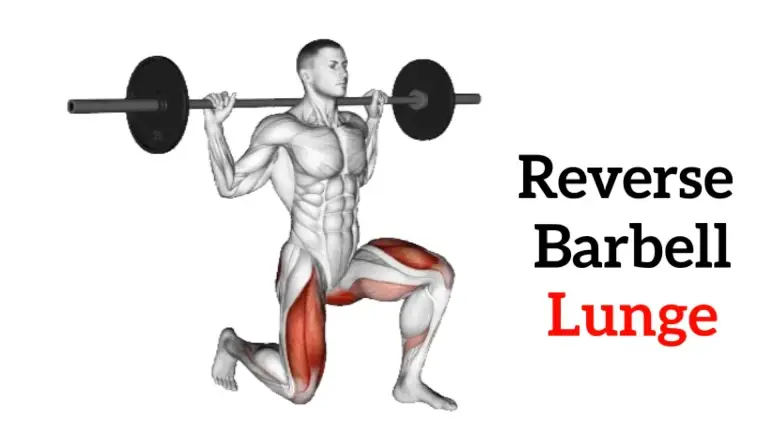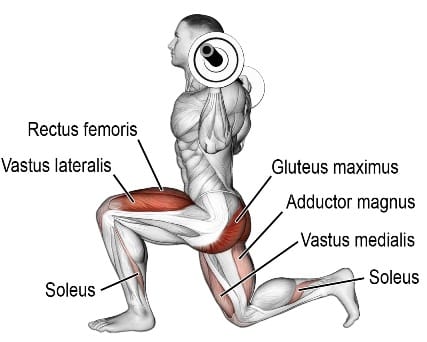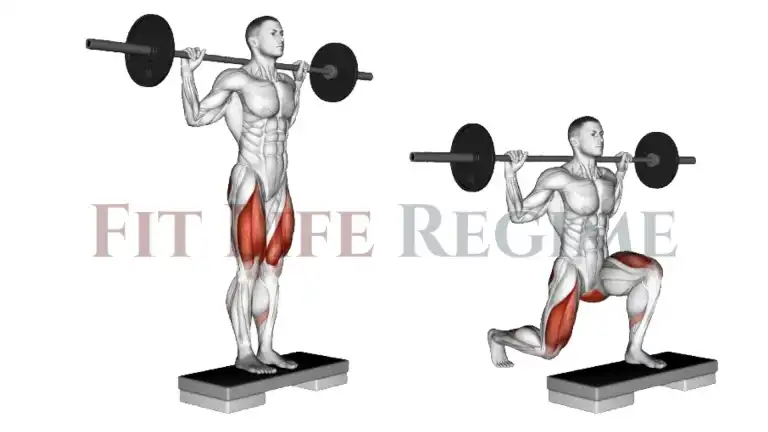Barbell lunges are great for strengthening the Quads, glutes, and hamstrings. However, they can be tough on the knees, therefore, many people opt for reverse barbell lunges, which take some load off the knee joints.
You step backward in this movement instead of stepping forward with one leg. And it is an excellent and less stressful on the knee’s variation of lunges to build thigh muscles and glutes.
Note: The barbell reverse lunge is also known as the rear lunge, backward lunge, and back lunge.
Let’s get ready to unlock the secrets of the barbell reverse lunge: how to do, form, muscles worked, and variations – all in this quick guide.

Barbell Reverse Lunges Muscles Worked
Barbell reverse lunges are a compound exercise that primarily targets the muscles of the lower body while also engaging the core for stability and balance.
- The primary muscles targeted during reverse lunges are glutes, hamstrings, and quadriceps.
- Additionally, the reverse lunge engages your core muscles, including your abdominals and lower back, as well as your hip stabilizing and calf muscles.

How To Do Backward Barbell Lunges
- Load some weights onto your barbell and place it securely on your traps.
- Keep your torso upright. Inhale as you take a large step backward with one leg and plant your forefoot behind you.
- As you do so, flex the knee and hip of your front leg to allow yourself to descend into a kneeling position.
- However, do not allow your rear knee to contact the floor.
- Exhale as you get back up into the starting position by extending the knee and hip of your front leg and pushing off with your rear leg.
- Repeat the movement with your opposite leg.
- Keep switching between the legs with which you lunge backward.
Pro-Tips and Form
- Keep your torso upright and your head facing forward.
- Do not allow the knee of your back leg to touch the floor.
- As you bend the forward leg, be careful that the knee does not extend past the toes.
- If you suffer from balance problems, avoiding it or using your bodyweight while holding on to a steady object is best.
- Avoid arching your back during the exercise, which can strain the lower back muscle too much.
- Be mindful of your front knee position and avoid allowing it to collapse inward during the lunge. Keep your knee straight and balanced with your feet throughout the move to keep your body in line.
- You shouldn’t touch the knee to the ground while doing reverse lunges. You should always try to get your back knee as close to the ground as possible.
- For reverse lunges, begin with 3–4 sets of 10–15 repetitions on each side.
- Don’t rush through the lunges or use momentum to do them. You should focus on a slow, controlled descent, stopping briefly at the bottom.

Know More: 15 Best Barbell Leg Workout For Mass and Strength
Reverse Barbell Lunges Variations
The rear barbell lunges can be done differently to suit your fitness level.
- If you are new to the backward barbell lunge, you may want to modify it to make it easier. One way to solve this problem is to do a bodyweight lunge. Another approach is to use a lighter weight.
- If you are looking for a more advanced variation to stimulate different muscle fibers in the legs, then try landmine reverse lunge.
1. Barbell Landmine Reverse Lunge
The landmine setup provides an advantage over traditional barbell reverse lunges. When you secure one end of the barbell to a landmine or corner, you create a pivot point that helps stabilize the weight.
This subtle change in mechanics helps to better target the quadriceps. Additionally, the front-loaded barbell setup reduces the burden on your upper back and shoulders.

How To Do
- Position yourself with your feet at shoulder-width
- Grab the end of a barbell in a landmine attachment at waist height.
- Take a step back with one leg and allow both knees to bend.
- Bend your knees and lower your body until your back knee almost touches the floor.
- Stand up and extend the knee as you drive through the front foot, returning to the starting position.
- Make sure you complete an even number of repetitions on each leg during the time for the exercise.
Know More: Landmine Exercises for Building Muscle and Strength
2. Barbell Elevated Reverse Lunge
The barbell elevated reverse lunge, or deficit reverse lunge, is a challenging variation of the regular reverse lunge that targets the glutes and hamstrings.
The deficit is created by lunging backward from a raised platform. This makes it easier on the knees.
During this movement, the front foot is slightly raised, which makes the step-down at the end more difficult.

How To Do
- Standing on a weight plate or low step, place a barbell across your upper back.
- Keep your abdomen tight, break at the front knee, and step back with your opposite leg.
- Slightly lean your torso over your front thigh.
- Return to the start position and repeat.
3. Barbell Zercher Reverse Lunge
If you want to improve your lunge and split squat mechanics, try the Zercher Lunge.
People will be more likely to comment that the lift is dangerous when, in reality, the benefits outweigh the discomfort.

How To Do
- Hold a barbell in your arms. Stand with your feet hip-width apart and hands crossed over each other.
- Inhale and step back into a lunge on your left leg, making sure that the ball of your foot makes solid contact with the floor.
- Keep your spine neutral – you might feel like you’re leaning forwards slightly to maintain a neutral spine – and your right knee is tracking slightly over your right foot.
- Return to the starting position and repeat on the other side.
4. Front Rack Barbell Reverse Lunge
The barbell front rack reverse lunge is similar to the reverse barbell variation, except for placing the barbell in a front rack position.
The front rack position creates an entirely new challenge. The weight makes you move forward, so you need to work your core muscles.
It helps you to improve abdominal stability and body balance by keeping your core muscles engaged throughout the movement.
How To Do
- Start the exercise by loading the barbell.
- When you put the bar in the front rack position, make sure to put it on your anterior shoulders. This will prevent you from hurting your collarbone.
- Use momentum to ‘clean’ the barbell onto your
- Keep your elbows high and in front of you the entire time, with your hands close together by your neck.
- Initiate the movement by stepping backward with one foot while the front foot is rooted to the floor.
- Descend into a lunge position by bending at your hips and knees.
- You’ve reached the end once your back knee almost touches the floor.
- Reverse the movement by extending the knee of the front foot and slowly bringing the trailing leg back to the starting position.
Takeaways
Barbell Reverse Lunges are an excellent way for beginners to develop their leg strength and hip flexibility, balance, coordination, and agility.
They help you build the muscles in your legs that are neglected during other exercises like squats or deadlifts.
They also provide strength work for your core and are great for developing strong quads.
References
- Alkjaer T, Wieland MR, Andersen MS, Simonsen EB, Rasmussen J. Computational modeling of a forward lunge: towards a better understanding of the function of the cruciate ligaments. J Anat. 2012 Dec;221(6):590-7. doi: 10.1111/j.1469-7580.2012.01569.x. Epub 2012 Oct 11. PMID: 23057673; PMCID: PMC3512282.
- McClellan, Tim CSCS; Bugg, Barrett S. CSCS. Lunge Variations to Enhance Specificity in Tennis. Strength and Conditioning Journal 21(6):p 18, December 1999.
- Bezerra ES, Diefenthaeler F, Nunes JP, Sakugawa RL, Heberle I, Moura BM, Moro ARP, Marcolin G, Paoli A. Influence of Trunk Position during Three Lunge Exercises on Muscular Activation in Trained Women. Int J Exerc Sci. 2021 Apr 1;14(1):202-210. PMID: 34055138; PMCID: PMC8136561.

Manish is a NASM-certified fitness and nutrition coach with over 10 years of experience in weight lifting and fat loss fitness coaching. He specializes in gym-based training and has a lot of knowledge about exercise, lifting technique, biomechanics, and more.
Through “Fit Life Regime,” he generously shares the insights he’s gained over a decade in the field. His goal is to equip others with the knowledge to start their own fitness journey.
